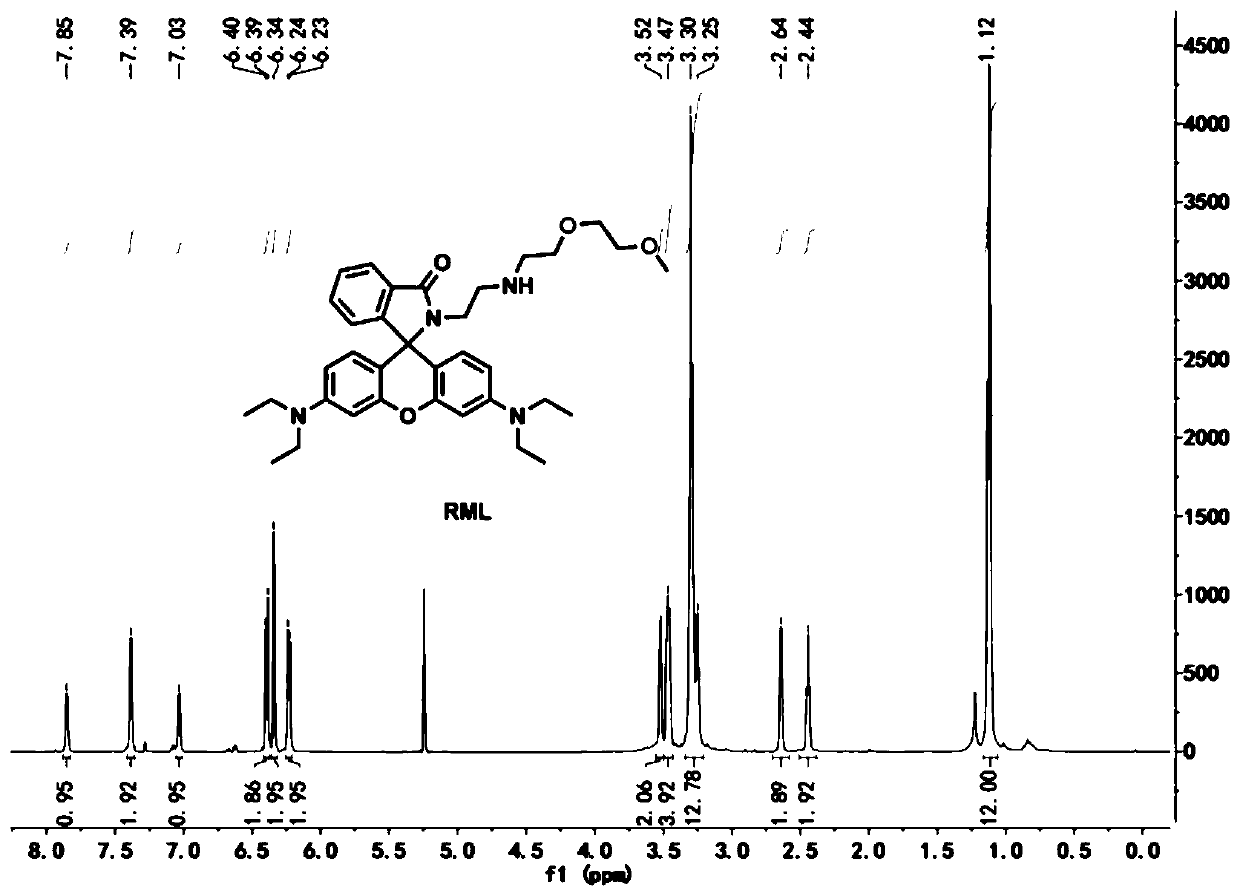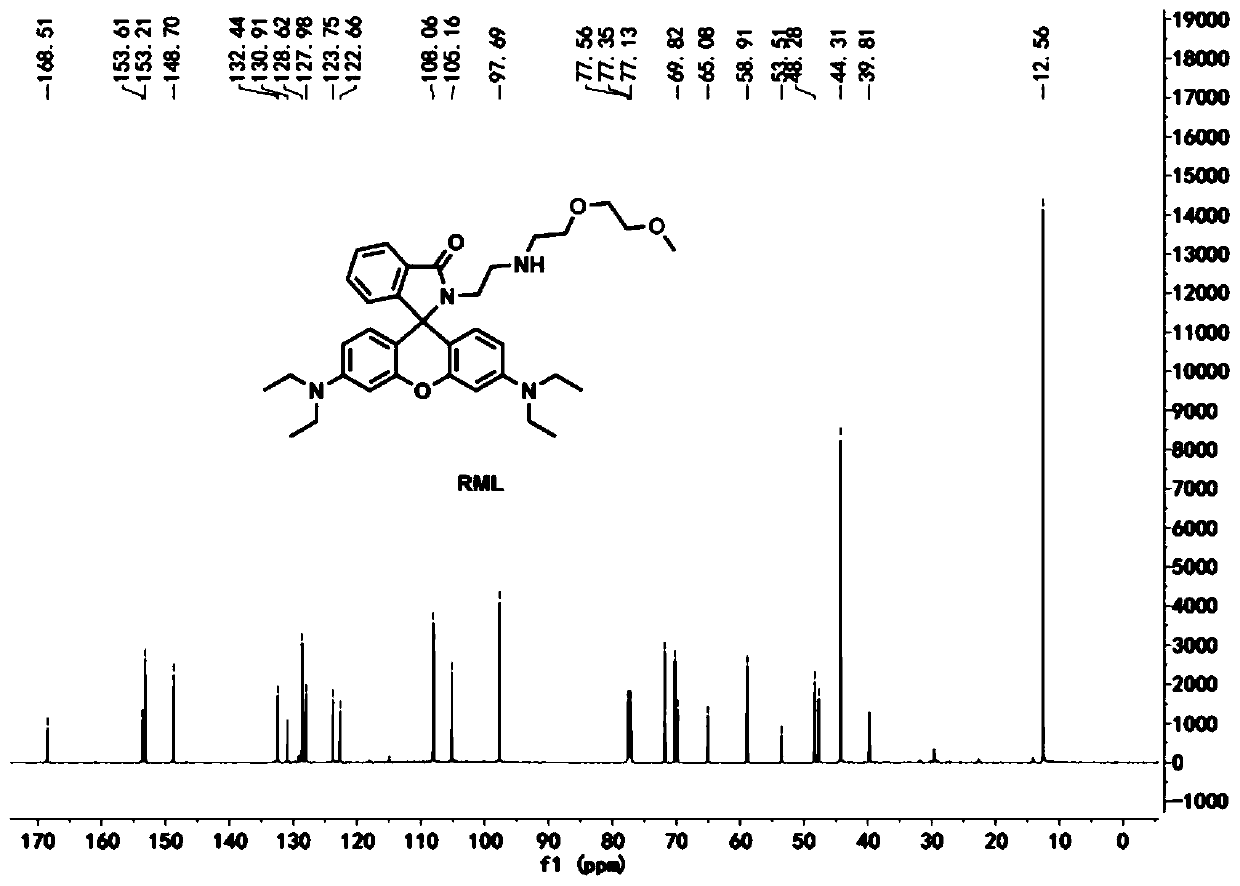Lysosome targeted pH fluorescent probe for monitoring cell autophagy as well as preparation and application thereof
A fluorescent probe and lysosome technology, applied in the field of pH fluorescent probes, can solve the problems of unsuitability for long-term detection, large cytotoxic side effects, strong background fluorescence, etc., and achieves good cell membrane permeability and easy mass production. , the effect of highly sensitive detection
- Summary
- Abstract
- Description
- Claims
- Application Information
AI Technical Summary
Problems solved by technology
Method used
Image
Examples
Embodiment 1
[0031] 3',6'-bis(diethylamino)-2-(2-((2-(2-methoxyethoxy)ethyl)amino)ethyl)spiro[isoindoline-1, Preparation and characterization of 9'-xanthene]-3-one (RML):
[0032]
[0033] In a round bottom flask, 2-(2-aminoethyl)-3',6'-bis(diethylamino)spiro[isoindole-1,9'-xanthogen]-3-one (170mg , 0.62mmol) and 2-(2-methoxyethoxy) ethyl 4-methylbenzenesulfonate (300mg, 0.93mmol) were dissolved in N,N-dimethylformamide, heated to reflux for 12h to react Complete; the system was cooled to room temperature, and the solvent was removed by rotary evaporation under reduced pressure to obtain a crude product; the crude product was purified by silica gel column (eluent chloroform:methanol=20:1 by volume) to obtain a light yellow solid as the target compound RML.
[0034] 1 H NMR (600MHz, DMSO-d6 , Figure 1a )δ(ppm):1.11-1.13(t,12H,-CH3-),2.44(s,2H,-CH2-),2.64(s,2H,-CH2-),3.32-3.30(m,13H,- CH 2 -),3.47(m,4H,-CH 2 -),3.52(m,2H,-CH 2 -),6.23-6.24(d,2H,Ar-H),6.34(s,2H,Ar-H),6.39-6.40(d,2H,...
Embodiment 2
[0038] The fluorescent probe RML in Example 1 was prepared as a stock solution with a concentration of 1 mM in dimethyl sulfoxide and preserved. In the experiment, the probe was diluted to a final concentration of 25 μM with Britton-Robinson buffer (BR) at different pH values, and the UV absorption spectrum ( image 3 ). As the pH value decreased from 7.4 to 4.5, the absorption peak at 561nm gradually increased. At the same time, the color of the solution changed from colorless to pink ( Figure 4 ).
Embodiment 3
[0040] Also dilute the probe to a final concentration of 10 μM with Britton-Robinson buffer with different pH values, fix the excitation wavelength at 560 nm, and record the change of the fluorescent probe RML with pH in the DMSO / BR (1 / 99, v / v) system Fluorescence emission spectrum changes. As the pH value decreased from 7.4 to 4.4, the fluorescence intensity at 583nm gradually increased ( Figure 5 ). At the same time, the fluorescent color of the solution changed from colorless to red ( Figure 6 ). According to the Singmoidal fitting curve calculation of the fluorescence intensity value of the fluorescent probe RML at 583nm as a function of pH, the pKa value is 4.96 ( Figure 7 ), the pH response linear range is 4.5-5.7, which is very suitable for the detection of pH changes in the weakly acidic environment of lysosomes.
PUM
 Login to View More
Login to View More Abstract
Description
Claims
Application Information
 Login to View More
Login to View More - R&D
- Intellectual Property
- Life Sciences
- Materials
- Tech Scout
- Unparalleled Data Quality
- Higher Quality Content
- 60% Fewer Hallucinations
Browse by: Latest US Patents, China's latest patents, Technical Efficacy Thesaurus, Application Domain, Technology Topic, Popular Technical Reports.
© 2025 PatSnap. All rights reserved.Legal|Privacy policy|Modern Slavery Act Transparency Statement|Sitemap|About US| Contact US: help@patsnap.com



